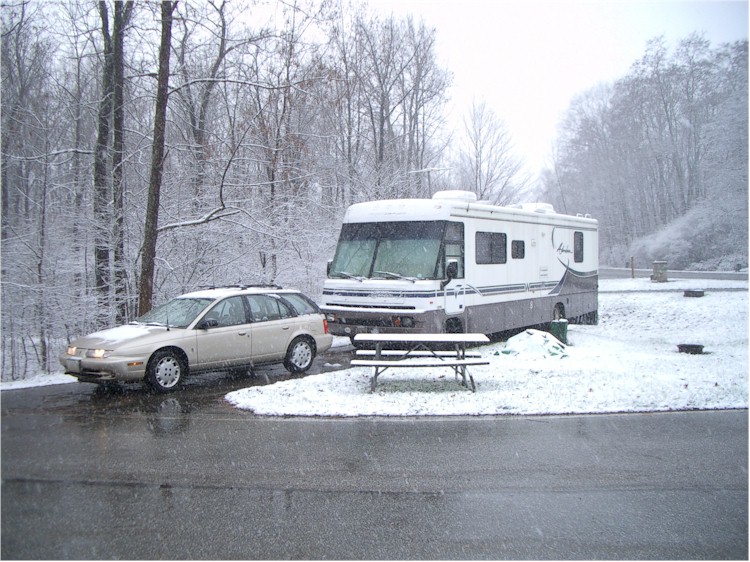
Wolf's Motorhome Modifications
... and Other Stuff
Winter Camping
Disinformation
You would not believe the amount of disinformation there is on winter camping. Please, if someone tells you you can't do this or that, ask them if they ever did it. Nine times out of ten they will try to quote some expert rather than answering you directly.
We ARE winter camping and have been for many, many years.
Ohio
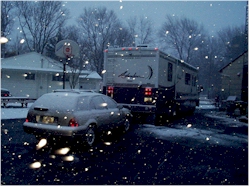 Winters in Ohio are typically at freezing to December then plunge to frigid
in January and February. Week long stretches of below zero are common. Rarely
does it go much below minus 20. We have snow off Lake Erie. Seems as if some
on the newsgroup are confused as to how cold it gets in northern Ohio. It gets cold!
Winters in Ohio are typically at freezing to December then plunge to frigid
in January and February. Week long stretches of below zero are common. Rarely
does it go much below minus 20. We have snow off Lake Erie. Seems as if some
on the newsgroup are confused as to how cold it gets in northern Ohio. It gets cold!
We are blessed with an Ohio State Park system that stays open all year. Not only that, they appreciate you coming out. I've come to find out that in many states finding a place to camp in the winter can be a challenge. That's sad. Maybe that's why their residents think you can't winter camp in an RV.
Times are good in Ohio.
Winterizing
I rarely winterize. We are out too often to worry about it. But ...
My first motorhome, a no-name knock off class-C had terrible problems with freezing pipes. The second and the current, both Winnebagos, have the poly-vinyl-what-do-you-call-it tubing; the kind that doesn't break when it freezes. When winterizing, all I have to worry about is the faucets and the pump.
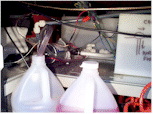 The pump on
both Winnebagos was designed to be quickly winterized. There is a valve in the line
between the water tank and the input to the pump. This valve allows me to redirect
where the pump is getting its supply. It is redirected to a hose that is put in a
bottle of antifreeze. After the pump is another valve. This valve determines
if the output of the pump is pumped into the motorhome or overboard through a waste
pipe. By toggling these two valves, I can draw antifreeze into ONLY the pump.
Great, no?
The pump on
both Winnebagos was designed to be quickly winterized. There is a valve in the line
between the water tank and the input to the pump. This valve allows me to redirect
where the pump is getting its supply. It is redirected to a hose that is put in a
bottle of antifreeze. After the pump is another valve. This valve determines
if the output of the pump is pumped into the motorhome or overboard through a waste
pipe. By toggling these two valves, I can draw antifreeze into ONLY the pump.
Great, no?
The water tank needs to be drained. Until I installed an AC heater element I had a drain plug. The installation of the element forced me to install a waste valve under the cabinets that allows the hot water tank to fully drain.
I have four faucets to worry about. The first is the most important! DON'T FORGET THE TOILET! I have a valve that allows me to toggle where the toilet is getting water. It gets it either from the motorhome supply or from a tube. I can toggle that valve and, using a small hand pump made for the purpose, pump antifreeze into the valve of the toilet.
The rest of the valves get a short squirt of antifreeze back flushed into them.
Done! You use ... maybe a quart of antifreeze.
Un-winterizing
First I fill the water tank and pump water overboard through the pump. This clears the pump of any antifreeze. I then run water through the system until it's clear.
If you want to purify your water tank use bleach. Bleach is the only thing that will kill everything. Its the only thing (according to the Red Cross) that will kill the AIDS virus. A couple of cups of bleach poured into a full tank and left to sit for a few hours will clean out almost all odors. No, a couple of cups of bleach over 50 or 100 gallons will not rot your pump, pipes or valves. Pure 100% bleach might oxidize any metal (if you have any). But we're not using pure bleach and probably have precious little metal to oxidize.
Instead of Winterizing
I normally shoot a squirt of antifreeze into the pump and heat the motorhome to just above freezing. I keep a 1500 watt electric heater in the utilities compartment. That heat drifts into the main motorhome and keeps things toasty to about zero. If needed, a second heater kicks on inside the coach.
Stuff to Bring
You just can't beat a snow shovel for shoveling snow. I've tried lots of things but when I forget my snow shovel I always realize that nothing beats it. Ohio State Parks promise to get you out if you get in. Many times I've had to find a maintenance person to plow out a site I wanted. BUT! They'll plow the roads, you have to shovel out what they plow into your site. Trivial? Visit our northern Ohio snow belt in the winter.
Driving in the Snow
I've found the motorhome to be much preferred over a car in the snow. It seems to have much better traction. I tend to drive much slower and more carefully. Take a look at all the trucks out in the snow. Do they hole up? Heck no! Just take it slow and careful.
We Got the Power
We keep our motorhome warm with electric heaters. Sorry, LP furnaces just don't have the necessary stuff to keep a winter camper toasty when compared to electric heat. They do fine when the temperatures go down to minus ten. Then you need all you can get. I just can't stand trying to heat with a furnace that seems to create more wind chill than heat.
In order to allow ourselves to keep enough heaters going we need enough amps. Most State Parks don't care if you grab power from another site (or two). Winter campers are few. A 50 amp plug is a real bonus!
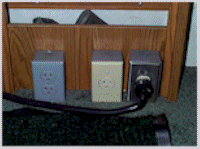 Two
additional outlets were added. One is in the front of the motorhome and one in the
rear bedroom. Each outlet is supplied by 10 gauge wire to an additional plug in the
utility compartment. Hence, I can plug a separate line into a separate plug going to
a separate outlet. The photo shows the front outlet and two 12 volt DC outlets
discussed on the ham radio page.
Two
additional outlets were added. One is in the front of the motorhome and one in the
rear bedroom. Each outlet is supplied by 10 gauge wire to an additional plug in the
utility compartment. Hence, I can plug a separate line into a separate plug going to
a separate outlet. The photo shows the front outlet and two 12 volt DC outlets
discussed on the ham radio page.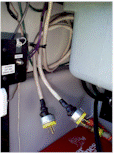
The heaters are typical 1500 watt units. Be sure to get heaters that have safety devices that shut them off when they tip over.
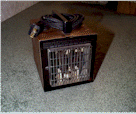 Unfortunately,
the thermostats on every heater I've tried have failed to meet the needs of a winter
camper. For this reason, I've built up two outboard thermostats. Each plugs
into an outlet with the heater plugging into it. Each has a RV thermostat that
controls a 30 amp relay mounted in the electrical box. You can not use mercury
switch thermostats in a motorhome. Even with levelers there are times that the
mercury bounces around. The RV thermostats work much better.
Unfortunately,
the thermostats on every heater I've tried have failed to meet the needs of a winter
camper. For this reason, I've built up two outboard thermostats. Each plugs
into an outlet with the heater plugging into it. Each has a RV thermostat that
controls a 30 amp relay mounted in the electrical box. You can not use mercury
switch thermostats in a motorhome. Even with levelers there are times that the
mercury bounces around. The RV thermostats work much better.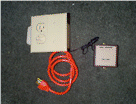
By placing the thermostat in the place best suited to the motorhome, you have much better control of the electric heaters.
Our record cold campout was minus 18 degrees F. The kids had a ball skiing and sledding although I think the motorhome thought it a bit brutal.
Where to Dump in the Winter
This is another area of terrible misinformation. For about 12 years I camped in a 1984 Winnebago Chieftain in the winter. Our holding tanks were hanging out in the breeze behind the motorhome. They would freeze SOLID. In 12 years I had no damage from freezing.
When I came home, I would park the motorhome with the tanks frozen. If the temperatures warmed up a bit, I would go out and thaw them out. I put pieces of plywood around the outside of the motorhome making a box around the back. Using a kerosene torpedo heater, I would blow warm air into that box for eight or ten hours. When all was liquid, I would go dump. Nothing to it.
Now I have a basement. My tanks are kept toasty by a heater and I can dump at will.
I dump into my sanitary test tee that is installed on my property
line. In fact, I've built a box around it so I can get to it easy enough.
Someday I will install my own dump station where I park the motorhome!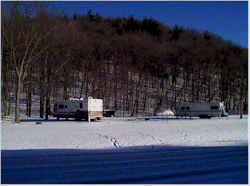
Pumping Heat into the Basement
Under another page (HERE) I discuss keeping the basement warm.
Please STAY HOME!
If you don't think it can be done, please ... stay home. There are more and more winter campers and their number is increasing. Eventually it will be tough to scarf power from more than one site. You're absolutely correct! You can't freeze holding tanks. You can't take a full tank of water and take showers, etc. You're right. Stay home.